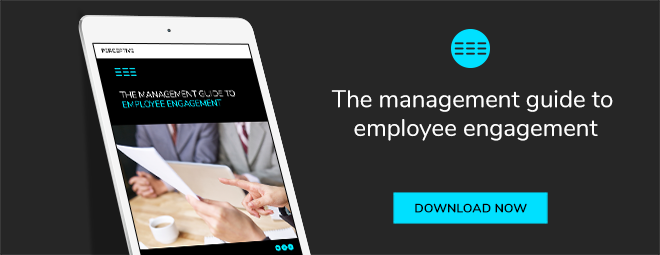
We all want our employees to be happy and engaged in their work, right? But sometimes this is easier said than done.
Employee engagement is present when employees show signs of job satisfaction, motivation, and high performance and productivity. But getting employees engaged in the first place is often the sticking point.
What does engagement mean?
Employees engage with different elements of their work, including day-to-day tasks, line managers, colleagues, the organisation and other stakeholders. This engagement does vary over time in its intensity and depth. Providing employees with a sense of purpose, clear expectations for their role, the right environment, training, tools, support, and career and development opportunities are critical elements of employee engagement.
When exploring levels of staff engagement for clients, we identify two types: emotional engagement and transactional engagement.
Related content: The 10 Pillars of Employee Experience
Emotional engagement
This generally occurs when people identify closely with their work, want to contribute, and feel satisfied in the way they contribute to the goals and values of the organisation. Emotionally engaged staff are more likely to have a strong sense of purpose and values. They have positive feelings about work and have made significant efforts in terms of emotional and financial investment in the workplace.
Emotionally engaged people build deeper connections with clients and colleagues, experience higher levels of wellbeing, and are more likely to act in the best interest of the team or the organisation rather than for themselves. They may question and challenge change if change may not be in the best interest of the team. They may do this because they have invested emotion and long-term sustainability over the business.
Emotionally engaged staff may show interest in helping others and carry out their duties conscientiously, accepting minor frustrations and behaving with courtesy and respect toward others.
Transactional engagement
Is generally present when the employee recognises the two-way partnership with the employer and measures the investment they put into the work in terms of effort and commitment and weights it against the rewards they get in terms of money, status, career advancement and satisfaction. They can display some level of alignment with the organisation’s purpose and values as long as it suits their personal goals. However, they may not necessarily believe in those values.
Transactional engaged staff have less emotional attachment to their job or employer. They may work well in the short term, however, they are more likely to fall into employee burnout, and optimal performance may not be sustainable over time. They may be keen to work extra hours and carry out instructions without questioning them, even if these instructions are in detriment of the team or the organisation. Their satisfaction, motivation and effective elements may be present but it's difficult to determine to what extent.
The role of the manager on engagement
How much is management responsible for building employee engagement? As a manager, your behaviour can trigger and drive engagement—or disengagement. Research shows that people who believe they are fairly treated by their manager are more motivated and likely to feel healthy, while those who believe they are treated unfairly are more likely to feel stressed and unhealthy.
When people are treated fairly, they become emotionally engaged and display “citizenship behaviour”: they reciprocate back to the business and/or manager and go above and beyond when required.
In short, if you treat your staff unfairly—or favour certain staff over others—it’s likely your employees will become disengaged. This could be a domino effect that may create a negative impact on the productivity levels of the workplace.
But to have a clear picture of what, how and why people get engaged requires emotional intelligence—especially from managers.
What is emotional intelligence?
Emotional intelligence is the ability to identify, apply, understand and manage emotions in positive ways to relieve stress, communicate effectively, empathise with others, overcome challenges and defuse conflict.
What are the key aspects of emotional intelligence?
- Self-awareness: You have a clear understanding of moods, emotions and drivers of people.
- Self-regulation: You can control your impulses and moods.
- Motivation: You are passionate about your work for the organisation and pursue your goals with energy and persistence.
- Empathy: You understand the emotional makeup of others and connect with them.
- Social Skills: You’re proficient at managing relationships and building networks.
How to foster employee engagement as a manager
As a manager, you should foster autonomy and good judgement in your staff, encourage them to make sound decisions and build up their experience so they can trust their judgement in challenging situations. Leading by example, treating others fairly and with respect, as well as showing gratitude and commitment to your collaborators, goes a long way to getting buy-in from your staff and will, in turn, transform into positive employee behaviour.
Three ways you can support employee engagement:
- Supporting employee growth: Supportive managers work alongside staff to help them improve their work, and provide constructive feedback and evaluation.
- Interpersonal style and integrity: Managers with integrity respect confidentiality, treat employees fairly and apply policies.
- Monitoring direction: Managers establish clear goals and targets; and clearly communicate the guidelines that people should follow in the workplace, along with the attitudes and expected behaviours.
Autonomy: a critical motivator
At its core, management is about organising people to work as productively as possible, and having engaged employees is essential for achieving that purpose. If you really want to foster true employee engagement, start with employee autonomy.
Studies have linked autonomy to higher job satisfaction, better wellbeing, and longer tenure among employees.2
Allow staff to manage aspects of their job, such as:
- Time: When they do what they do.
- Task: What they actually do.
- Team: Whom they work with.
- Technique: What approach they use to get results.
- Accountability: The reward of putting in practice autonomy and self-direction.
- Mastery: The desire of constantly improving something that is meaningful to us.
- Purpose: The reason why we do things that are beneficial, rewarding and challenging at the same time.
Interestingly, recent research now also suggests that men and women are affected differently by different aspects of workplace autonomy.
For women, flexibility over the timing and location of their work appeared to be more beneficial, allowing them to balance other tasks such as family commitments. While men were found to be more impacted by job tasks, pace of work, and task order.
Fostering employee emotional engagement on a permanent basis is important to achieve your company’s goals in the short, medium and long term. Managers should be mindful of the emotional intelligence skills required to create rapport and should work on mastering the competencies to support employee engagement.
Lastly, if you’re committed to boost engagement in your staff, measure your levels of engagement across the company so you can monitor where you’re succeeding and where you need more work. By doing this, you’re giving yourself a roadmap to strong employee engagement over time.
Learn effective strategies to implement change in your business with our free guide.
Fast Company, How Fairness at Work Affects Your Health, 2016
